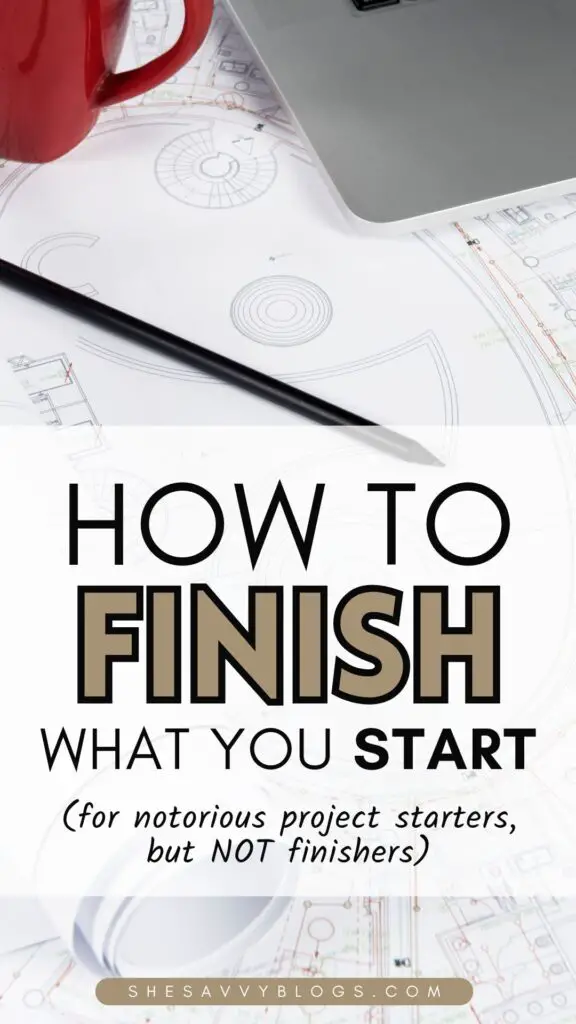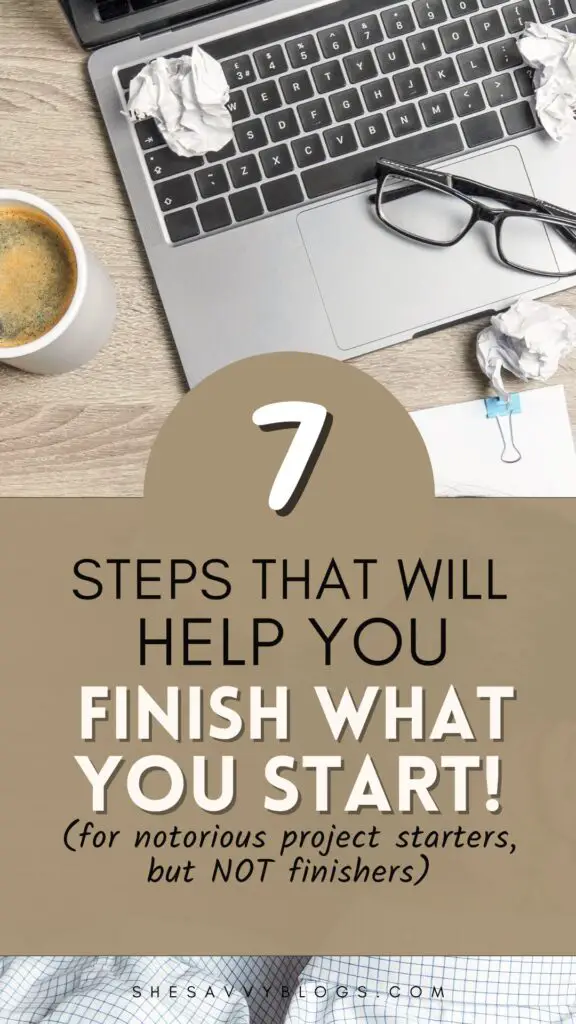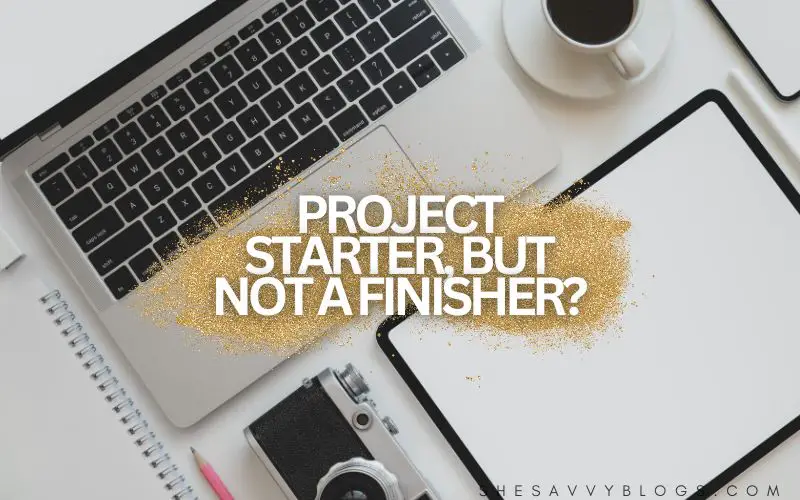*This post may contain affiliate links. That means I may earn a small commission from qualifying purchases or sign-ups at certainly no additional cost to you! Thanks!*
I’m a notorious project starter.
I’d be like, working on some ambitious plans today, and then starting a new creative side gig next month. I am that idealistic.
Bet Gabriel, my partner, got his hands full with me due to all the changed plans he dealt with me.
But ugh, I can’t help it.
The endless possibilities excite me. I get hooked!
But while we can have endless conversations about new and fresh ideas, I guess I’ll let you in with a secret.
Those big, bold projects? The truth is, I couldn’t count how many of them I’ve abandoned.
It’s embarrassing… but I never quite made it to the finish line.
Many of my so-called goals never reached completion.
When I was young, it was okay. Start, get bored, and move on.
But when I entered adulthood, every failure started to break my heart little by little.
I know I’m not lazy. So why am I so quick to give up on things?
Why do I always quit? Will I ever succeed if I continue like this?
These were my questions back then. And I was so lost.
Thankfully, through years of trial and error, anxieties, and finding my purpose, I finally learned to overcome my biggest issue.
I learned to love progress, which led me to reach completion.
This is what I’ll share with you today. How did I do it?
In this post, we’ll discuss the steps and tips I used to stop being a goal-hopper and actually finish what I started.
Ready? Here we go!
How to Finish What You Started (And Become a Project Finisher)

1. The What: Write Your Goals
The first step to finishing what you’ve started is to define your goals clearly.
Grab your pen and paper.
You have to write down what you really want to achieve, both long-term and short-term.
For me, what I do now is usually write easily achievable goals that can be achieved in the near future.
Say, writing my first e-book about INFP personality, which took me about 3-4 months if I remember.
Or preparing for a licensure exam, which would also take another three months.
Just write whatever goals you have in mind, don’t be shy.
It’s not like we’re gonna do them all immediately, but we’re just simply planting that goal in our hearts and waiting for the perfect timing to execute it.
Why write them? So just you can check your heart, and monitor your dreams and desires.
I admit that sometimes, my goals lose their luster after a few weeks or months. Other times, they keep nudging me like a sweet kid, whispering a little, “Give it a try!” which is a sign that, yep, maybe I should give this plan a shot.
Don’t hesitate to write your hundreds of goals down. And be not afraid if that plan either evolves or disappears as the days progress.
Life happens, and your perspective changes.
Just go and write them down.
2. The How: Write an Outline of How To Make Your Goal Possible
Now, pick one of those goals. No, you can’t do everything all at once.
Don’t be too optimistic.
Been there, done that, and that’s one of the biggest reasons that hindered me from completing any projects.
As of now, pick one.
Once you pick a clear goal—whether short—or long-term—the next step is to map out how to achieve it.
The problem with project starters like me is that we start on the wrong foot. I mean, we start with a boom, boom, pow—a fiery motivation!
Only that, when the fire dies down, we’re left with nothing but an empty plan, no structure, no nothing.
This is the time when we create a structure. An outline of steps of how to get there.
We just get a picture (and a list!) of the probable steps, obstacles, and needed resources. If you think it’s possible to make it happen at this point in time, then go for it.
But if you think you don’t have a certain skill set, money, or time and resources yet, set it aside for a while. Let it sit there on your list.
Choose a more doable goal.
Related Post:
- How To Focus When You Have Too Many Goals In Life
- 5 Things That Stop You From Living Up To Your Potential
3. The When: Draw a Timeline
Oh, you’re still here? Then, you may have decided to outline your steps for a certain goal.
We’ll proceed to Step 3: draw a timeline.
I’m not a fan of New Year’s Resolutions because, ugh, they’re often just empty promises.
But I do set my goals yearly and quarterly as if I’m a corporate company with an annual performance goal set in stone.
In my yearly timeline, I designate a quarterly plan to ensure that:
One, I won’t get bored. (I have to stir things up!)
Two, I have about 3 months to prepare myself and my resources.
And three, my many plans won’t overlap with each other. I have a quarterly highlight!
For example, January to March might be slower due to the post-holiday lull, so I focus more on work during that period. No plans, really, just my normal work day. I’m recovering from the Holidays.
Then, from April to June, I shift to other plans, like traveling with family and friends.
For three months, I would look for new places, invite friends and urge them to fit their schedule for a travel date, prepare needed materials, and such. Try my outfits, and even work out if we’re out for the beach.
July to September has another set of plans. And the fourth quarter of the year, another set!
You can draw your own timeline. Just make sure that tasks don’t overlap with each other and that you’re not juggling major goals at the same time.
Related Post: How to Have An Organized Month, Week, or Day
4. “Done” not “Perfect”
I am – I mean — I was a perfectionist.
Back then, I found beauty in a perfect performance, draft, or drawing. That’s why I worked long hours and days before I let anyone see what I was working with.
I don’t like showing mediocre work.
However, the downside of being a perfectionist is this: Surprise, surprise, I rarely finish anything.
When all things feel mediocre and imperfect, I’d rather tap out than put my name in a plan that was below my visions and standards.
However, I realized that although perfectionism has its good sides, the truth is, perfecting everything takes too much time.
If we’re not careful, the next thing we know, we’re facing a dreaded deadline with an incomplete output.
Truly, some situations need COMPLETION rather than PERFECTION.
“Complete and done” is better than “Supposedly perfect yet abandoned.”
5. Decide What You Can Finish In A Day
Now that you have a timeline, let’s pace ourselves.
Be honest to yourself. How much work can you truly finish in a day?
I used to think I could finish big tasks like writing an entire chapter of my manuscript in a day. But ha! Who am I kidding?
I can’t. I often bit more than I can chew.
No wonder my motivation fizzles out when I can’t meet these idealistic expectations.
To avoid this, I’ve learned to break my tasks into more manageable chunks.
Ask yourself, What can I realistically achieve today?
Like, for real. As per your experience, how much time do you spend to write a chapter?
How much distance can you run and still won’t feel depleted for the entire day?
How many responsibilities can you juggle at work without burning out?
That’s it. Burnout — never let yourself reach this point.
Thus, choose smaller, consistent progress rather than big, massive steps that get out of control.
Be self-aware when and how you’re losing steam. Once you identify your capacity, then pace up or pace down.
6. Seek external sources or advice when it gets hard.
Okay, how about when we feel stuck in the middle of our plans?
Seriously, roadblocks happen!
So what should we do whenever we hit a roadblock or feel stuck?
What I do — I seek answers and solutions from external resources.
Yep! I don’t hesitate to reach out to others—talk to friends, mentors, or colleagues who might offer advice or a fresh viewpoint.
We can also turn to external resources like books, podcasts, or even online communities that share valuable insights.
Whenever I lose sight of the goal, I watch video podcasts with similar experiences, and voila! My will to live—I mean, ideas—are fresh again!
Sometimes, just hearing someone else’s journey or reading about new techniques can reignite your enthusiasm. This will help us move forward!
7. Build a habit and your body will move on its own.
Build a habit. And did you know it takes 66 days for it to be automatic in our lives?
Do a task for 66 days, and your body will look for it, especially if it’s something you really enjoy.
With discipline and habit, you would no longer rely on motivation, which is solely based on emotions.
Rather, you show up even when you don’t feel like it.
Over time, what feels difficult at first will become second nature.
Your body and mind will start moving on autopilot, and tasks that once felt like a chore will turn into part of your daily routine—something you even look forward to.
What to Keep in Mind If You Don’t Finish Your Project
So, what if despite trying the steps above, you still didn’t finish that project you started?
Before you start feeling like a failure, let’s take a step back and look at the bigger picture.
Here are the possible reasons why you still give up despite all the planning you did:
1. You’re not incapable; you’re exploring.
Not finishing doesn’t mean you lack ability; it means you’re still figuring things out.
In these times, we’re in the process of exploration, learning what works for us and what doesn’t.
I’ve made numerous plans that I have given up on. But looking at them now, they’re not useless attempts.
These experiences are valuable lessons in discovering our strengths and interests.
I now consider those “failures” as my greatest testimonies because they directed me to where I am today!
2. The plan may not have aligned with who you are.
It’s entirely possible that, as you progressed, you realized the project or goal wasn’t in tune with your deeper desires or values.
Maybe you started something that felt right at the time, but as you went further, you found it wasn’t really your thing. That’s not failure—it’s self-awareness, so don’t lose heart.
Better to pivot now than continue down a path that’s out of sync with who you truly are.
3. Distracting ideas? Explore them!
Ever notice how, in the middle of working on one thing, another brilliant idea pops into your head and won’t leave you alone?
When that happens, I usually give room for that idea. I try that idea out so I could get it out of my system.
If the ideas work, then good! If it doesn’t, still very good!
Better to check that distraction off the list, right?
4. Evaluate how much you enjoy the process.
If you find joy in the process, that’s a clue to your true strengths and purpose.
On the other hand, if the process feels like a struggle every step of the way, it might be a sign to shift your focus to something that feels more aligned with your passion.
Conclusion
The art of organizing and finishing a goal is different from the goal itself.
As we go through a plan, evaluate, adjust, and keep moving forward, even if the destination shifts along the way.
In the end, unfinished projects aren’t wasted efforts. They teach you about yourself—what excites you, what drains you, and how you work best.
That’s it! I hope this gave you insights. Thanks for reading! God bless! 🙂

You may also like:

